
Spyridium globulosum, commonly known as basket bush, is a species of flowering plant in the family Rhamnaceae and is endemic to coastal areas in the south-west of Western Australia. It is a shrub with relatively large leaves and heads of flowers covered with whitish hairs.

Melaleuca cuticularis, commonly known as the saltwater paperbark is a tree in the myrtle family, Myrtaceae and is native to the south-west of Western Australia. There is also a disjunct population on Kangaroo Island in South Australia. It is distinguished from other melaleucas by its unusual fruits and very white, papery bark.
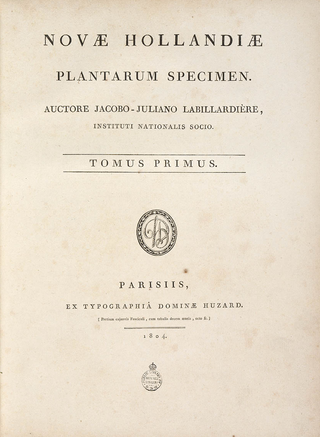
Novae Hollandiae Plantarum Specimen is a two-volume work describing the flora of Australia. Facsimiles of the originals can be found in the online Biodiversity Heritage Library (Vol.1) and Vol 2).

Ozothamnus ferrugineus, commonly known as tree everlasting, is a member of the genus Ozothamnus, of the Asteraceae family – one of the largest families of flowering plants in Australia. Native to the Australian states of New South Wales, Victoria, South Australia, and Tasmania, it forms an erect shrub or small tree between 2 and 3 metres in height.
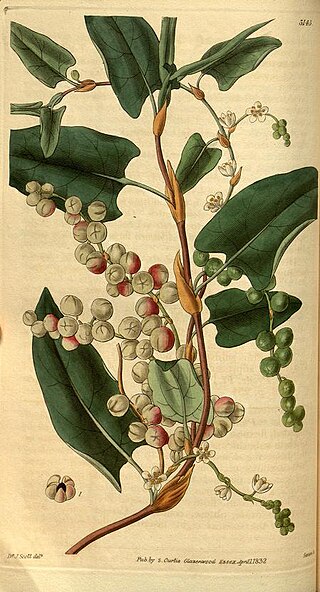
Muehlenbeckia adpressa, commonly known as climbing lignum, is a prostrate or climbing plant, native to Australia. It has thin red-brown stems up to 1 metre in length. The leaves are 1.5–6 centimetres (0.59–2.36 in) long and 1.5–3.5 centimetres (0.59–1.38 in) wide. It occurs in coastal areas of Western Australia, South Australia, Tasmania, Victoria and New South Wales.
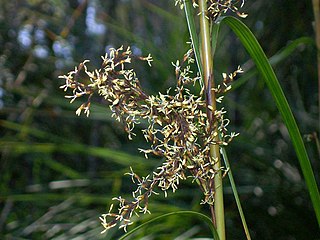
Gahnia melanocarpa, known as the black fruit saw-sedge, is a tussock forming perennial plant in eastern Australia. Often found in the wetter forests or in rainforest margins, it is common on the coast but also seen in the tablelands.

Hibbertia cuneiformis, commonly known as cut-leaf hibbertia, is species of erect or sprawling shrub that is endemic to the south-west of Western Australia. It grows to between 1 and 2 m tall and has yellow flowers which appear from January to March or from June to November in the species' native range.

Pimelea ferruginea, commonly known as pink rice flower or coastal banjine, is a species of flowering plant in the family Thymelaeaceae and is endemic to near-coastal areas of south-western Western Australia. It is a dense, erect shrub with elliptic to narrowly elliptic leaves and head-like clusters of pale to deep pink, tube-shaped flowers.
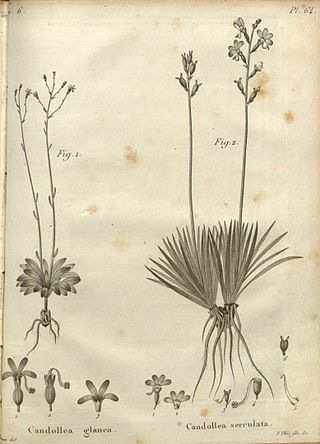
Stylidium glaucum, the grey triggerplant, is a herbaceous plant found along the southern coast of Southwest Australia, West of Albany. The plant attains a height between 0.15 and 0.65 metres. The leaves are lanceolate in form, becoming pointed at the base, and moderately acute at the tip. These are between 20 and 70 millimetres in length and 2 to 9 millimetres in width, are hairless, and have an entire margin. The trivial name of the species, glaucum, refers to the greyish colour of the leaves. The scape is hairless, supporting a racemose arrangement of white or pink flowers that appear from January to May.

Lepidosperma filiforme, also known as the common rapier-sedge, is a sedge that occurs in coastal regions of south-eastern Australia and New Zealand. Plants grow to between 0.3 and 1 metre high. The culms are smooth, rigid, terete and between 0.7 and 2 mm in diameter. The leaves are also terete and about 1 mm in diameter, with sheaths that are straw coloured or reddish.

Melaleuca thymoides is a plant in the myrtle family, Myrtaceae, and is endemic to the south-west of Western Australia. It is usually a low shrub. The ends of the branches usually end in a sharp spine and the leaves also have a sharp point. Bright yellow flowers appear on the ends of the branches in spring or early summer.
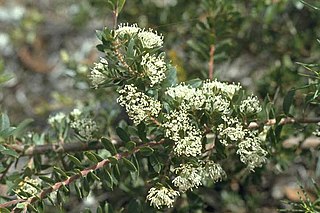
Hakea ruscifolia, commonly known as the candle hakea, is a shrub in the family Proteacea. It has fragrant white flowers, arching branches and spiky foliage. It is endemic to an area in the Peel, Wheatbelt South West, Great Southern and the Goldfields-Esperance regions of Western Australia.
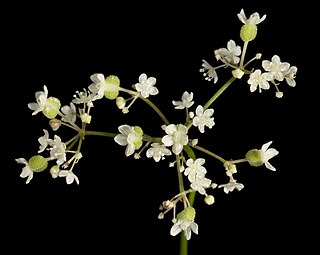
Platysace compressa, commonly known as the tapeworm plant, is a perennial herb that is endemic to Western Australia.

Lepidosperma squamatum is a species of flowering plant in the sedge family, Cyperaceae. It is native to Southwest Australia. It was described by Jacques Labillardière in Novae Hollandiae Plantarum Specimen (1805). The specific epithet squamatum is derived from the Latin for 'scale', in reference to the form of the bracts.

Leucopogon obovatus is a species of flowering plant in the heath family Ericaceae and is endemic to the southwest of Western Australia. It is an erect shrub with hairy young branchlets, variably-shaped, simple leaves, and erect clusters of 3 to 15 white, bell-shaped flowers on the ends of branches and in upper leaf axils.
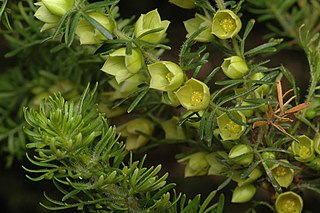
Boronia tetrandra, commonly known as yellow boronia, is a plant in the citrus family, Rutaceae and is endemic to Western Australia. It is a spreading or erect shrub with hairy stems, pinnate leaves and greenish cream to yellow or reddish brown, cup-shaped, four-petalled flowers.
Anarthria scabra is an herbaceous plant found in Southwest Australia.

Leucopogon collinus, commonly known as fringed beard-heath, is a species of flowering plant in the heath family Ericaceae and is endemic to south-eastern Australia. It is a slender, erect or spreading shrub with narrowly lance-shaped leaves, and white, tube-shaped, bearded flowers.
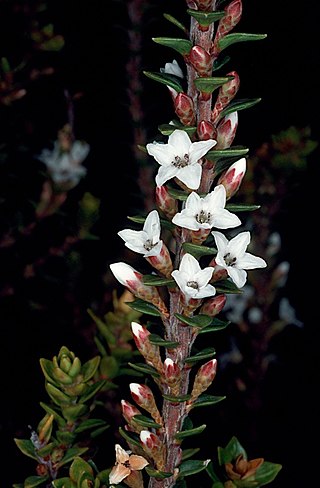
Epacris myrtifolia is a species of flowering plant in the heath family Ericaceae and is endemic to Tasmania. It is an erect shrub that typically grows to a height of 15–50 cm (5.9–19.7 in). Its leaves are thick, crowded, egg-shaped with a small, blunt point on the tip, and 4.2–8.5 mm (0.17–0.33 in) long. The flowers are arranged singly in a few upper leaf axils with many leathery bracts at the base. The sepals are leathery, about 4.2 mm (0.17 in) long, the petal tube slightly shorter than the sepals with lobes about the same length, the anthers protruding slightly from the petal tube.
Pimelea clavata is a species of flowering plant in the family Thymelaeaceae and is endemic to near-coastal areas and offshore islands of southern Western Australia. It is an erect shrub with narrowly elliptic to more or less linear leaves arranged in opposite pairs, and head-like clusters of white to pale yellow, tube-shaped flowers surrounded by leaf-like involucral bracts.


















